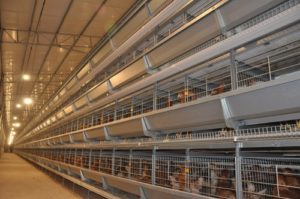Layer chicken cages are used to raise layer hens, generally from 8 weeks of age, into the cage, after raising to 72 weeks of age to complete a production cycle, they are eliminated from the cage. Therefore, under the good environmental conditions of the chicken house, it is necessary to have a reasonable structure of the chicken cage to enable the laying hens to exert their highest production efficiency.
The size of the layer cage must be able to meet its certain activity area, feeding position and height. At the same time, in order to make the laid eggs roll out of the cage in time, the cage bottom should have a certain inclination. According to the above requirements, the arrangement of layer cages must be composed of many small single cages. There are several ways to raise 3 or 4 animals in each small cage, and there are several ways to raise 6 or 8 animals.
The size of the single cage of a layer cage is generally 380-450 mm in front height, 300 mm in rear height, 9-10 degrees in the bottom of the cage, 350-600 mm deep in the cage, and the egg collecting trough outside the cage is 120- 160 mm. The width of the cage depends on the feeding position, the feeding position of each chicken is 100-110 mm.

There are two forms of manufacturing and installation of single cages, namely, integral and assembled. The integral type is to form a single cage of several units into a whole. It is characterized by easy installation, but consumes materials, is difficult to handle and easily deformed after being made. The assembly type adopts an integral cage frame, and there are two forms of manufacture and installation of the single cage, namely the integral type and the assembly type. The integral type is to form a single cage of several units into a whole. It is characterized by easy installation, but consumes materials, is difficult to handle and easily deformed after being made. Assembled type is to use the overall cage frame. After the overall cage frame is installed, hang the cage nets and serve. It is characterized by neat installation, easy replacement and maintenance. The assembly type is more common in actual production.
The side nets and the back nets are mainly used as the spacing of the cage, and metal wires with a diameter of 2 to 2.5 mm can be distributed in a horizontal grid. The thick wire in the warp direction is arranged on the outside, with an interval of 100 to 200 mm; the thin wire in the weft direction is arranged on the inner side, with an interval of 30 mm, which can prevent the chickens from pecking each other.
The bottom net not only has to bear a certain weight, but also has to drop the feces without dropping the eggs, and it must have a certain degree of flexibility, so that the eggs are not easy to break when laying, and the chickens have a certain sense of comfort when moving. The metal wires are distributed in a vertical grid. Use thick wires in the warp direction on the surface with an interval of 22-25 mm; in the weft direction, use thin wires on the bottom with an interval of 50-60 mm, so that the eggs can be rolled out smoothly along the slope of the warp direction.
The width of the cage door of the poultry farming layer cage is determined by the width of the single cage. Generally, a vertical fence is welded with a 3 mm diameter metal wire, with a spacing of 50-60 mm. The cage door is 400 mm high, and its lower edge should be 50-55 mm away from the bottom net to leave the egg-going space; or an egg guard 50 mm away from the lower edge can be placed in the cage to prevent the egg trap from being trapped. Eggs are pecked by chickens, and chicken manure is discharged into troughs and sinks.